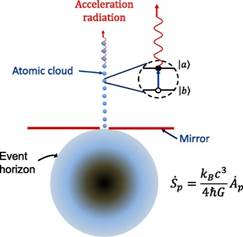
cientists have explored novel quantum effects on the radiation emitted from a black hole due to atoms freely falling into it. This investigation of atoms falling into a black hole could throw new light on the efforts of scientists towards unification of quantum mechanics which plays out at the smallest scales of matter and the general theory of relatively propounded by Einstein which is applicable at the largest cosmological scales.
The two most successful scientific theories of the past century are the general theory of relativity and quantum theory. Quantum theory describes the microscopic behaviour of fundamental particles whereas the general theory of relativity accurately describes the motion of objects or particles around a massive object which is the exact mathematical description of the theory of gravitation at the classical level.
A fundamental building block of the general relativity theory is the observation by Einstein which states that the laws of nature remain the same if an experiment is done in a small enough region in the presence of a gravitational field compared to the same experiment done in the absence of gravity. This is called the principle of equivalence which is completely classical. Scientists have been trying to experimentally observe the validity of the principle of equivalence in a quantum mechanical scenario.
A fundamental consequence of the general theory of relativity is the existence of a black hole. This astrophysical object is characterised by something known as the event horizon. This is a hypothetical sphere of a certain radius from which nothing can escape once the object falls into it. Considering the effects of quantum mechanics on a black hole, Stephen Hawking predicted that they can also emit radiation—termed the Hawking radiation. It has not been possible to detect Hawking radiation till date because the cold radiation from the black holes gets drowned in the 2.7-degree Kelvin cosmic microwave background radiation of the universe.
A team of scientists (Dr. Sunandan Gangopadhyay, Mr. Soham Sen, and Dr. Rituparna Mandal) from S.N. Bose National Centre for Basic Sciences, an autonomous institute of the Department of Science and Technology have investigated the radiation of atoms falling into a black hole having quantum corrections embedded into it. Their mathematical calculations reproduced earlier results that this radiation is similar to the Hawking radiation (emitted by black holes) and has special features that provide insights to the Einstein principle of equivalence.
The radiation which arises due to the relative acceleration between the atom and the field surrounding it is generated from the two-level atoms unlike the radiation emitted from the black hole as predicted by Hawking. The amount of disorder known as entropy was calculated for this radiation emitted from the atoms, and this was called the “horizon brightened acceleration radiation entropy” (HBAR entropy).
While similar work has been undertaken previously, this research stands out due to the finding that the HBAR entropy obeyed the area law along with logarithmic leading order area corrections and the inverse order of area subleading corrections, the Union Ministry of Science and Technology said in a press communique on July 24, 2023.
“We carried out the calculation for a quantum-corrected black hole metric and obtained the HBAR entropy, and observed that the equivalence principle holds in a general setting as well. The HBAR entropy obeyed the area law along with logarithmic leading order area corrections and the inverse order of area subleading corrections,” said Dr. Sunandan Gangopadhyay, leader of the team investigating the phenomenon of acceleration radiation of two-level atoms.
References:
1. S. W. Hawking, Nature 248 (1974) 30-31.
2. M. O. Scully et. Al., Proc. Nat. Acad. Sciences 115 (2018) 8131-8136.
3. S. Sen, R. Mandal and S. Gangopadhyay, Phys. Rev. D 105 (2022) 085007.
4. S. Sen, R. Mandal and S. Gangopadhyay, Phys. Rev. D 106 (2022) 025004.







